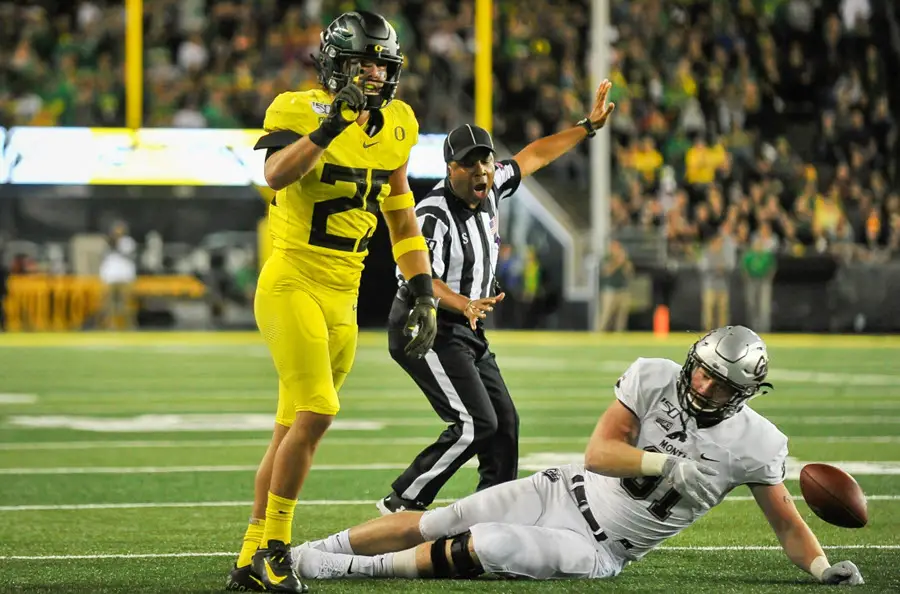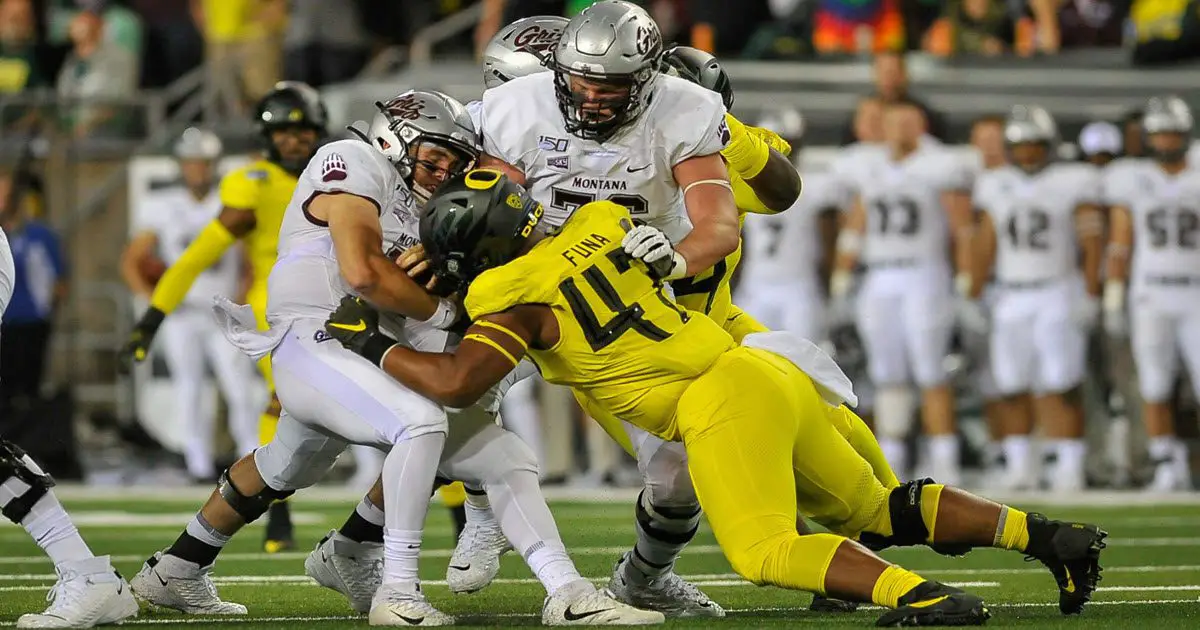It has been eight quarters and nine seconds since the Oregon Ducks gave up a touchdown. In the last two games, Oregon has allowed a total of nine points. Through three total games, Oregon is allowing only 272.3 yards per game.
The Oregon defense has absolutely dominated the early season. Here are some reasons why.
The Ferocious Front Seven
Through the first three games, Oregon has 28 tackles for loss, tied for 16th nationally and first in the conference. Those tackles are mostly conducted by the front seven of the defense. Oregon lost two starting linebackers and a defensive end from a decent 2018 front seven, leading to questions about the front seven heading in to the 2019 campaign.
Consider those questions answered.

The front seven harassed Montana all day long
Andy Avalos’ defensive line has defended the run effectively against every opponent so far, controlling the point of attack and directing ball carriers toward tackling machines in the middle of the defense. The defense is allowing a staggeringly low 2.59 yards per carry on the season, helped along by the 28 tackles for loss.
The front seven has further disrupted opposing offenses by getting sacks. An impressive 10 sacks on the season has the Ducks sitting at 20th nationally and first in the Pac-12.
Led by true freshman Mase Funa (three sacks), the Ducks have been able to get consistent pressure on opposing quarterbacks, leading to big losses and dead drives.
Overall, the Oregon front seven has been dominant, smothering ball carriers and creating big plays.
Savage Secondary
A front seven can only blitz like the Ducks have been doing if the coaching staff has a high level of confidence in the secondary playing behind them. Luckily for Avalos, he is working with one of the most talented defensive backfields in Oregon history. The Ducks rank 25th nationally, and second in the conference, in passing yards per game, allowing only 173.3.
Oregon fans will recall the Swiss cheese that was the Mark Helfrich secondary year in and out. Chip Kelly employed a bend-but-don’t-break defensive scheme, focused on forcing turnovers from offenses desperate to keep up with his own. In contrast, the plan by Avalos and Mario Cristobal seems to be “Don’t let the other team move the football down the field.”

Brady Breeze has hit with ferocity in 2019
Avalos’ scheme requires players like Thomas Graham and Deommodore Lenoir to stay focused on their downfield assignments and hold the edges. Additionally, Jevon Holland and Nick Pickett provide necessary playmaking over the middle of the defense, while young defensive backs like Verone McKinley III and Mykael Wright provide much needed depth across the board.
The Oregon secondary is as talented and productive as the Ducks have ever had, and now they have the scheme to show off their potential.
Turnover Terrorizers
Oregon has forced seven total turnovers: five interceptions and two fumbles. Those numbers are good for ninth nationally and fourth in the Pac-12.
The Ducks’ five interceptions rank third nationally and second in the conference. Interceptions are often started by the front seven pressuring opposing quarterbacks and ended by a secondary that is in the right place at the right time.
One of the defense’s two fumbles was returned for a touchdown by Brady Breeze against Nevada. If the Ducks are going to win a conference championship, that is unlikely to be the last defensive touchdown for the season.
One of the best marks of a defense is its ability to get off the field, and forcing turnovers is the fastest way to do that.
Efficiency
Third-down efficiency is the measure of how well a defense is able to end opponents’ drives. The Ducks currently rank 37th nationally and second in the conference, allowing opponents to convert only 31 percent of their third downs.
While not as mind-blowing as other statistics, third-down efficiency is more likely to change rank-wise as teams’ schedules even out during the season.
Overall Outlook
So far, the Oregon defense has been dominant, allowing 36 points in three games. Considering that the 2018 defense gave up 60 points through its first three games, against a much easier schedule than this year’s, the defensive improvement is obvious.
The question moving forward is this: can Oregon sustain the suffocating defense for the entire season, or is there a Pac-12 offense capable of putting up impressive numbers on them?
Ryan Robertson Top Photo Credit: Kevin Cline
Yuma, Arizona
 Bob Rodes, the FishDuck.com Volunteer editor for this article, is an IT analyst, software developer and amateur classical pianist in Manchester Tennessee.
Bob Rodes, the FishDuck.com Volunteer editor for this article, is an IT analyst, software developer and amateur classical pianist in Manchester Tennessee.
Ryan Robertson is a defense contractor for the United States Marine Corps. A lifelong Duck fan from Grants Pass, he joined the Army out of high school. After four years as an Intelligence Analyst he decided it was time to further his education and pay more attention to his Ducks. One of Ryan’s first memories is of watching the Ducks, led by Joey Harrington, beating up on the Utah Utes in 2001. His grandfather ran track at Oregon in the ‘50s. He loves the Ducks, and has a passionate interest in reading every scrap of analysis centered around the football team.

